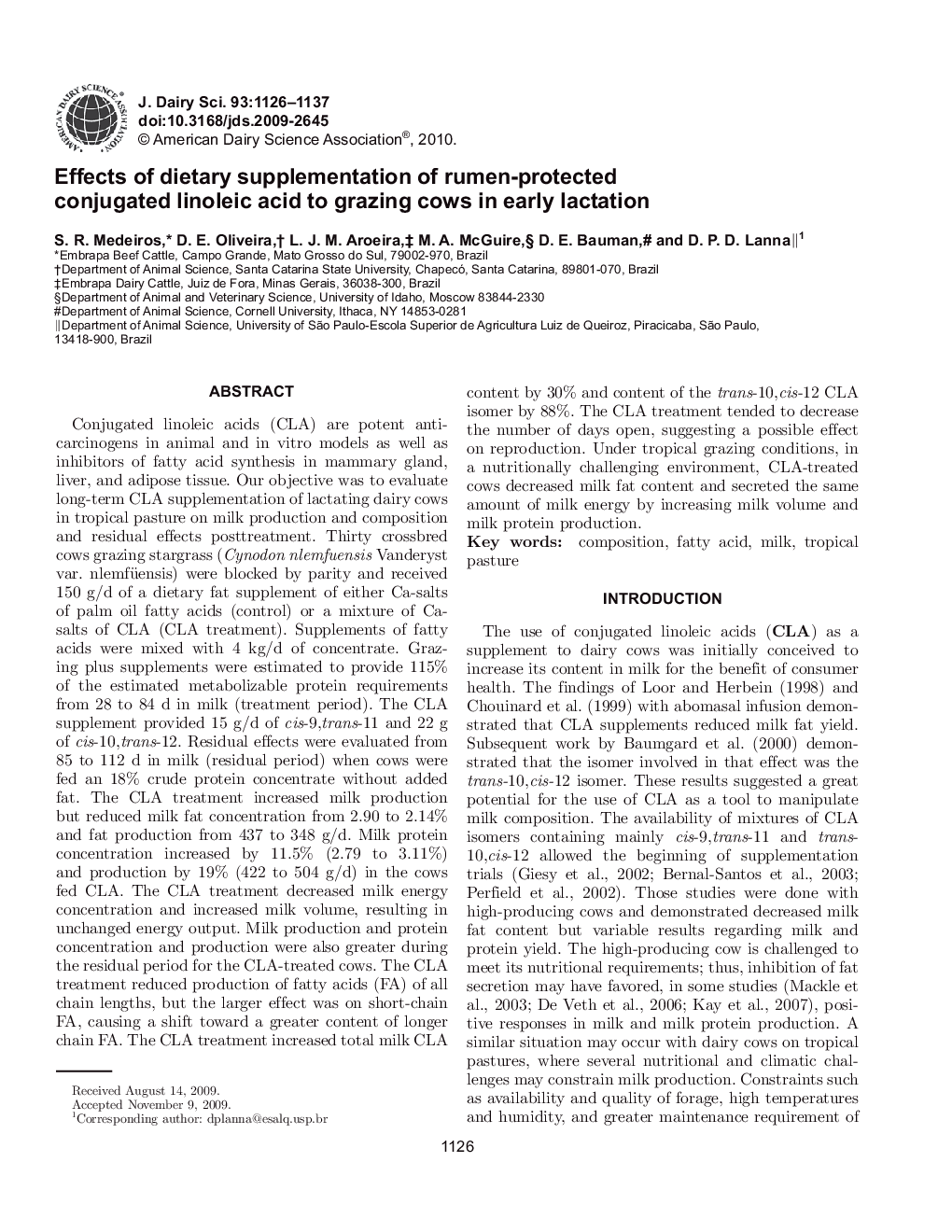| کد مقاله | کد نشریه | سال انتشار | مقاله انگلیسی | نسخه تمام متن |
|---|---|---|---|---|
| 10981870 | 1108079 | 2010 | 12 صفحه PDF | دانلود رایگان |
عنوان انگلیسی مقاله ISI
Effects of dietary supplementation of rumen-protected conjugated linoleic acid to grazing cows in early lactation
دانلود مقاله + سفارش ترجمه
دانلود مقاله ISI انگلیسی
رایگان برای ایرانیان
کلمات کلیدی
موضوعات مرتبط
علوم زیستی و بیوفناوری
علوم کشاورزی و بیولوژیک
علوم دامی و جانورشناسی
پیش نمایش صفحه اول مقاله

چکیده انگلیسی
Conjugated linoleic acids (CLA) are potent anticarcinogens in animal and in vitro models as well as inhibitors of fatty acid synthesis in mammary gland, liver, and adipose tissue. Our objective was to evaluate long-term CLA supplementation of lactating dairy cows in tropical pasture on milk production and composition and residual effects posttreatment. Thirty crossbred cows grazing stargrass (Cynodon nlemfuensis Vanderyst var. nlemfüensis) were blocked by parity and received 150 g/d of a dietary fat supplement of either Ca-salts of palm oil fatty acids (control) or a mixture of Ca-salts of CLA (CLA treatment). Supplements of fatty acids were mixed with 4 kg/d of concentrate. Grazing plus supplements were estimated to provide 115% of the estimated metabolizable protein requirements from 28 to 84 d in milk (treatment period). The CLA supplement provided 15 g/d of cis-9,trans-11 and 22Â g of cis-10,trans-12. Residual effects were evaluated from 85 to 112 d in milk (residual period) when cows were fed an 18% crude protein concentrate without added fat. The CLA treatment increased milk production but reduced milk fat concentration from 2.90 to 2.14% and fat production from 437 to 348 g/d. Milk protein concentration increased by 11.5% (2.79 to 3.11%) and production by 19% (422 to 504 g/d) in the cows fed CLA. The CLA treatment decreased milk energy concentration and increased milk volume, resulting in unchanged energy output. Milk production and protein concentration and production were also greater during the residual period for the CLA-treated cows. The CLA treatment reduced production of fatty acids (FA) of all chain lengths, but the larger effect was on short-chain FA, causing a shift toward a greater content of longer chain FA. The CLA treatment increased total milk CLA content by 30% and content of the trans-10,cis-12 CLA isomer by 88%. The CLA treatment tended to decrease the number of days open, suggesting a possible effect on reproduction. Under tropical grazing conditions, in a nutritionally challenging environment, CLA-treated cows decreased milk fat content and secreted the same amount of milk energy by increasing milk volume and milk protein production.
ناشر
Database: Elsevier - ScienceDirect (ساینس دایرکت)
Journal: Journal of Dairy Science - Volume 93, Issue 3, March 2010, Pages 1126-1137
Journal: Journal of Dairy Science - Volume 93, Issue 3, March 2010, Pages 1126-1137
نویسندگان
S.R. Medeiros, D.E. Oliveira, L.J.M. Aroeira, M.A. McGuire, D.E. Bauman, D.P.D. Lanna,